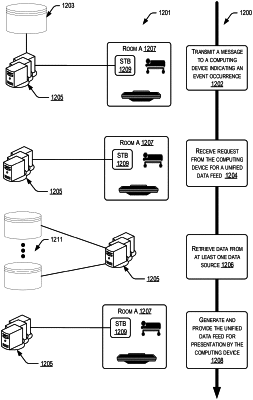| CPC G06F 16/248 (2019.01) [G06F 16/27 (2019.01)] | 19 Claims |

|
1. A computer-implemented method, comprising:
maintaining, by a computer system, an association between a device identifier of a computing device and a location identifier of a particular location of a service facility, the computing device being assigned to the particular location of the service facility and communicatively connected to a display at the particular location;
receiving, by the computer system, a request from the computing device for a unified data feed corresponding to the particular location, the request being independent of a particular user presently being serviced at the particular location and including a device identifier of the computing device;
retrieving, by the computer system from a user processing service, a user identifier that identifies a user that is currently being serviced at the particular location, the user processing service storing real-time data that associates the user currently being serviced with the location identifier;
determining, by the computer system, that the particular user is the user presently being serviced at the particular location;
retrieving, by the computer system, first data and second data associated with the servicing of the particular user, respectively from a first data source and a second data source of a plurality of data sources, the first data source being distinct from the second data source, the plurality of data sources respectively including at least one of: (I) a dietary data service, (II) a real-time location system (RTLS) service, (III) a user data service, (IV) a user education content service, or (V) an entertainment content service;
generating, by the computer system, a unified data feed that includes at least the first data and the second data, the unified data feed including parameters for formatting and presenting a home screen on the display, the home screen displaying at least one of (I) content derived from the first data or the second data, or (II) a selectable element that is associated with displaying additional content associated with the first data or the second data;
providing, by the computer system, the unified data feed to the computing device for presentation of the home screen at the display at the particular location;
receiving, by the computer system, a second request from the computing device for a second unified data feed corresponding to the particular location;
generating, by the computer system, the second unified data feed for a second user that is currently being serviced at the particular location;
providing, by the computer system, the second unified data feed to the computing device for presentation of the home screen at the display at the particular location;
receiving, by the computer system, traffic data, respectively, from one or more computing devices of a plurality of computing devices of the service facility, the plurality of computing devices including the computing device and respectively assigned to a particular unique location within the service facility, the respective traffic data associated with a data feed between the respective one or more computing devices and a third-party service;
analyzing, by the computer system, the respective traffic data from each of the one or more computing devices to determine a respective level of quality of network service between the one or more computing devices and the third-party service;
determining, by the computer system and based on analyzing the traffic data, a network traffic pattern, the network traffic pattern indicating that a portion of the one or more computing devices has a lower quality of network service compared to other computing devices of the one or more computing devices that interact with the third-party service;
determining, by the computer system, the particular unique location for each computing device of the portion of the one or more computing devices within the service facility;
determining, by the computer system, that the network traffic pattern of the portion of the one or more computing devices is localized to a particular region within the service facility based at least in part on the particular unique location for each computing device of the portion of the one or more computing devices; and
transmitting, by the computer system, a message to a user device for presentation by the user device, the message providing instructions for performing maintenance service targeting the particular region of the service facility.
|